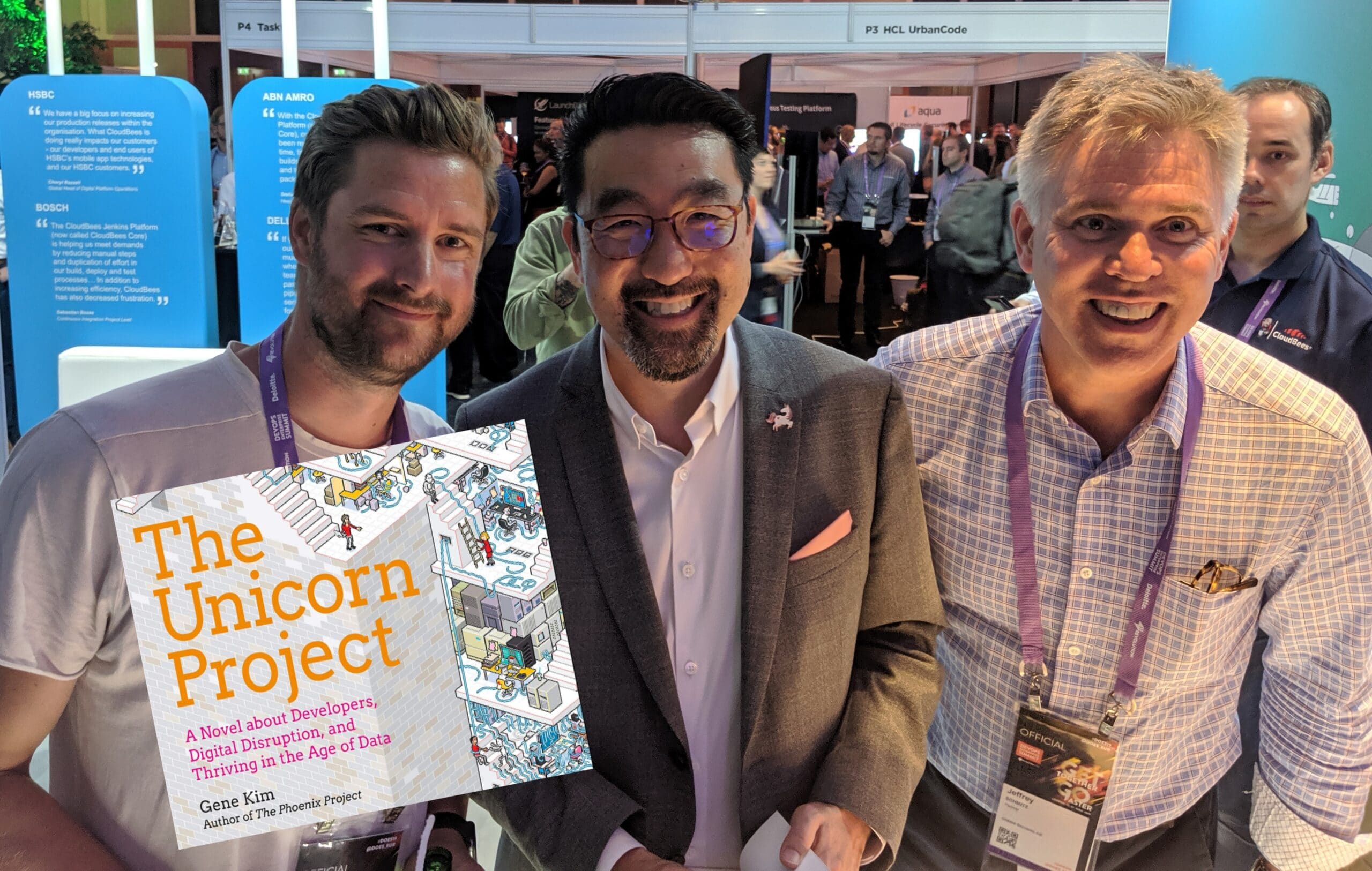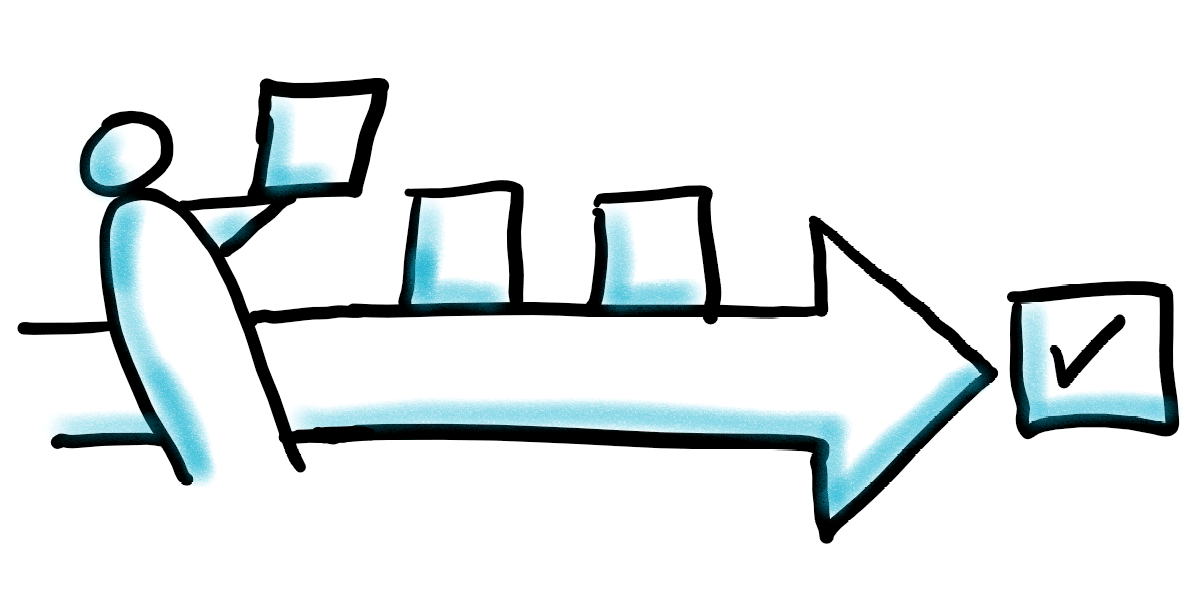The Five Ideals of the Unicorn Project
As a central figure in DevOps and IT improvement, Gene Kim has been involved in studying high-performing technology organizations during the past two decades. His book “The Phoenix Project” (2013) is a fictional account of an IT organization struggling to survive the everyday challenges so many of us recognize. And now in “The Unicorn Project”, Parts Unlimited is back and dealing with new and familiar challenges.
I had the pleasure of meeting Gene during the summer of 2019 at the DevOps Enterprise Summit London. He describes his intent with the Unicorn Project to be re-confirming the importance of the DevOps movement to achieve better value from our IT investment. Especially he wanted to focus in this book on the importance of the foot soldiers driving the important work – the developers and engineers at the heart of IT productivity.

Onbird’s Martin and Jeff with the author of The Unicorn Project, Gene Kim, at the DevOps Enterprise Summit in London 2019.
The Five Ideals
Central to the learning communicated by the book are the Five Ideals. (Gene has even recently started the Idealcast, his podcast of discussions with other experts regarding how organizations compete and win.) What follows is a summary of the Five Ideals.
The Five Ideals of the Unicorn Project
- Locality and Simplicity
- Focus, Flow and Joy
- Improvement of Daily Work
- Psychological Safety
- Customer Focus
The First Ideal: Locality and Simplicity
From the start of the book, the protagonist Maxine is confronted by a Parts Unlimited that does not display the First Ideal. Instead answers and assistance are hard-fought, and Maxine is forced to book meeting after meeting, seek out vendors and colleagues, and wait in queue after queue to make any progress. Possessing knowledge and the eagerness to produce IT improvement, her ability to create value for customer is severely limited by a number of internal hinders and bureaucracies.
Creating this difficulty is never an organizational intent yet happens so easily. And these situations are often a result of scale. The small gang of startup wizkids in the IT garage enabled speed and simplicity. The corporate IT department and band of outsourcing vendors seems to slow things way down with:
- Environments not allowing single/simple sign-on
- Architectural dependencies and incompatibilities between data and technology platforms
- Escalation procedures which force us to seek/await approval
- Technical- and/or skill-based bottlenecks
- Release schedules which force delays in deploying new value
How do we achieve/retain Locality and Simplicity? Here I think of a lot of the lessons learned from Lean thinking. We need to be diligent in not allowing the above bullet points to creep in. Instead we need to lock arms and wills to ensure:
- Teams with cross-functional skills
- Local (easily accessed) resources with the mandate to create change
- Simplicity of architecture, including the allusive “highly cohesive, loosely coupled” services
- Automated change pipelines for test, integration and deploy
- Continual feedback loops and improvement in trimming the processes and eliminating waste

The Second Ideal: Focus, Flow and Joy
“Joy?” you ask. “What does that have to do with efficient IT?”
Loads says the research. In one of my other favorite IT books (from 1975?!), “The Mythical Man-Month”, author Fredrick Brooks reminds us of how technology is a creative, problem-solving medium. And that the people that work with technology love to solve problems. I.e., it brings them joy!
Similarly, Kim reminds us in the Unicorn Project that we need to set up work environments and processes which enable focus and flow, thereby making problem-solving and joy possible. And what are the hinders to this?
- Technical debt
- Interruptions, bottlenecks, incidents…
- Complexity (see the First Ideal)
- Wait times for funding, assistance, approval…
Many of us recognize the frustration associated with the bullets above – the Second Ideal reminds us of the importance of removing these points of frustration. Much like the Scrummaster’s list of impediments, much (most?) of our work should be spent upon reducing impediments, thereby improving our production focus and flow. And when we achieve this flow, joy is often the inevitable product.
The Phoenix Project Business Simulation
Why not learn more about DevOps by throwing yourself into the book’s environment? We’ll take you on a Phoenix Project learning journey with our simulation based on the popular book. Learning by doing, it provides a great starting point for your DevOps initiative.
The Third Ideal: Improvement of Daily Work
Here again we hear the lessons of Agile and Lean – feedback, retrospectives, Kaizen and continuous improvement. All this is critical to maintaining speed and competitiveness.
Erik, the Sensei of the Phoenix and Unicorn books, even reminds us of the opposite of the Third Ideal, TWWADI – “The Way We’ve Always Done It”. TWWADI is symbolized with rules and regulations, processes and procedures, rigid project plans, approval processes, strict separation of duties and more. Each of the above adds to the coordination cost of work, drives delay and even conflicts with the First Ideal.
How do we fight TWWADI and support the Third Ideal?
- Increase feedback loops
- Give teams the resources to fix problems
- Prioritize solving technical debt
- Establish team authority and responsibility for improvement
Most of all, we need to lead our teams and organizations to make improvement in small steps an obvious, daily part of our work. We need to establish that pursuit of perfection in order to create long-term, continuous value to our customers.

The Fourth Ideal: Psychological Safety
Much like joy, psychological safety might sound as if it has little to do with world class IT. But if we consider the opposite – what are the results of people that work in insecure, untrusting, unsafe work environments? Perhaps we’ve seen it first-hand, but certainly it isn’t hard to envision that such an environment would adversely affect innovation, discourage exploration and risk-taking, and create a culture of blame and negativity.
Google’s Project Oxygen is referenced as a positive example here. Launched over ten years ago, Google has monitored and measured how managers and leaders can create the work culture and environment that supports psychological safety. Primarily they have set guidelines that teams:
- Do not embarrass, reject or punish someone for speaking up
- Address problems with “what is the cause?”, not “who”
- Commit to daily improvement (see the Third Ideal)
- Identify incidents as learning opportunities
- Teach each other continually
Much like productivity focus and flow, the Third Ideal reminds us that the right work environment is critical. And if we create this psychological safety? Sensei Erik sums it up – “You are in an organization where everyone is making decisions, solving important problems every day, and teaching others whay they’ve learned… Your victory is inevitable.”

The Fifth Ideal: Customer Focus
One of my standing bad jokes during training sessions, is that the correct answer to certification questions is “Value to Customer”. When in doubt, “Value to Customer”. Therefore, it rhymes well for me that the Fifth Ideal is Customer Focus.
This ideal can easily become a bad joke in the wrong context. We’ve all been hammered with customer value and IT-business alignment and customer first and digitalization and more and more… At the same time, we see repeated examples of a gap between IT and the customer.
The Unicorn Project’s biggest challenges and most difficult decisions arise when addressing the Fifth Ideal. Primarily, Maxine and her IT colleagues must consider all the work and value they are providing, and then prioritize between core customer value and many other nice-to-haves. True customer focus means prioritizing the machines, people, skills, softwares, projects, vendors and other components that provide ultimate value to the customer. And like all prioritization, the real challenge is not adding prioritized items, but removing them.
Rather than summarize the complexity of the Fifth Ideal in a few more sentences, I’ll let it be a cliff-hanger incentive to read the book. Suffice it to say that my bad joke is repeated. Value to customer is certainly the correct answer.
Everything about DevOps
Read more about DevOps (including our blog ”WTF is it?”) and don’t miss our training and business simulations.
När är ledarskapet det största hindret till flöde?
I vår strävan efter högre effektivitet, snabbare leveranser och bättre flöde är det lätt att förbise en avgörande faktor: ledarskapet. Ibland är det just vi som leder som skapar de största hindren för flöde och värdeskapande.
Kartläggning av värdeflöden
Att förstå hur arbetet faktiskt flyter genom organisationen från idé till kund är avgörande för att lyckas med förbättringar. Här berättar vi hur en värdeflödeskartläggning kan hjälpa dig till effektivare flöden, engagerade team och ökad kundnöjdhet.

